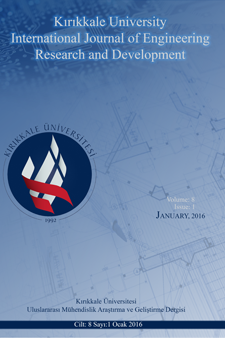Structural and Magnetic Study of Fe-15,83%Mn-2,18%V and Fe18,50%Mn-2,27%Cu Alloys
Structural and Magnetic Study of Fe-15,83%Mn-2,18%V and Fe18,50%Mn-2,27%Cu Alloys
Phase transformation, Magnetic properties Mössbauer spectroscopy, Scanning electron microscope,
___
- Askeland, D.R., (2003). The Science And Engineering of Materials (4th ed.). Thomson Learning Inc., California.
- Cotes, S.M., Cabrera, A.F., Damonte, L.C., Mercader, R.C.,& Desimoni, J. (2002). Phase transformations in Fe-Mn alloys induced by Ball Milling. Hyperfine Interactions 141/142 409-414. doi:10.1023/A:1021204909505.
- Cotes, S.M., Cabrera, A.F., Damonte, L.C., Mercader, R.C., & Desimoni, J.(2002). Magnetic properties of ball-milled Fe–Mn alloys. Physica B 320 274–277. doi:10.1016/S0921-4526(02)00711-1.
- Cotes, S.M., Guillermet, A.F., & Sade, M. (2004). Fcc/Hcp Martensitic transformation in the Fe-Mn system: Part II. Driving force and thermodynamics of the nucleation process. Metallurgical and Materials Transactions A, 23 83-91. doi:10.1007/s11661-004-0111-y.
- Jun, J.H., Kong, D.K., & Choi, C.S. (1998). The influence of Co on damping capacity of Fe–Mn–Co alloys. Materials Research Bulletin Vol. 33, No. 10 1419–1425. doi:10.1016/S0025-5408(98)00145-7.
- Kajiwara, S. (1984). Continuous observation of isothermal martensite formation in Fe-Ni-Mn alloys. Acta Metallurgica, 32 407-413. doi:10.1016/0001-6160(84)90114-7.
- Marinelli, P., Fernandez Guillernet, A., & Sade, M. (2004). The enthalpy change of the hcp → fcc martensitic transformation in Fe–Mn–Co alloys: composition dependence and thermal cycling effects. Materials Science and Engineering A 373 1–9. doi:10.1016/j.msea.2003.05.006.
- Nishiyama, Z. (1978). Martensitic transformations, Academic Press, London.
- Porter, D.A., Eeasterling, K.E., & Sherif, M.Y. (2009). Phase Transformations in Metals and Alloys (3.ed.). CRC Press, London, New York.
- Sarı, U., Güler, E., Kırındı, T., & Dikici, M.(2009). Characterization of martensite in Fe-25%Ni-15%Co-5%Mo alloy. Journal of Physics and Chemistry of Solid, 70 1226-1229. doi:10.1016/j.jpcs.2009.06.013.
- Sarı, U., Kırındı, T., Yüksel, M., & Ağan, S. (2009). Influence of Mo and Co on the magnetic properties and martensitic transformation characteristics of a Fe-Mn alloy. Journal of Alloys and Compounds 476 160–163. doi:10.1016/j.jallcom.2008.09.047.
- Sarı, U., & Kırındı, T. (2011). Effect of Mn content on the austenite-martensite phases and magnetic properties in Fe-Mn-Co alloys. Mateterials Chemistry and Physics, 130(2011)738-742. doi:10.1016/j.matchemphys.2011.07.063.
- Sumiyama, B.K., Kadono, M., & Nakamura, Y. (1981). Metastable bcc Fe-Mn alloys produced by rf sputtering. Transaction of the Japan Institute of Metals,Vol.22,No.10 686-690. doi:10.2320/matertrans1960.22.686.
- Yayın Aralığı: 2
- Başlangıç: 2009
- Yayıncı: -
Katı Atık Depolama Tesisi Yer Seçimi için Birleştirilmiş Hedef Programlama ve AHP yaklaşımı
Design of Remotely Controlled Hydraulic Bottle Jack for Automobile Applications
Aniekan IKPE, Aniekan IKPE, İkechukwu OWUNNA
Araç Rotalamada Karbon Ayakizi ve Endüstriyel Bir Uygulama
Bensu KAPLANSEREN, Betül MERCAN, Büşra ÖZDEMİR, Hatice Hazel KADIOĞLU, Çağrı SEL
Optical Bio-barcode Nanobiosensors
Fikret YALÇINKAYA, Abdulhamid HAMSHO
ATM Cash Flow Prediction and Replenishment Optimization with ANN
Sefik İlkin SERENGİL, Alper OZPİNAR
Sis Bilişim Tabanlı İmza Doğrulama: Senaryoya Dayalı Bir Yaklaşım
Structural and Magnetic Study of Fe-15,83%Mn-2,18%V and Fe18,50%Mn-2,27%Cu Alloys
Nermin KAHVECİ YAĞCI, Hasan İNAÇ
Hydrodynamic Analysis of Shark Body Hydrofoil Using CFD Methods
